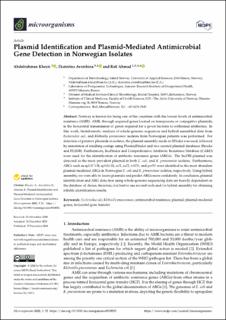| dc.contributor.author | Khezri, Abdolrahman | |
| dc.contributor.author | Avershina, Ekaterina | |
| dc.contributor.author | Ahmad, Rafi | |
| dc.date.accessioned | 2023-04-12T12:54:37Z | |
| dc.date.available | 2023-04-12T12:54:37Z | |
| dc.date.created | 2020-12-31T13:17:44Z | |
| dc.date.issued | 2020 | |
| dc.identifier.citation | Microorganisms. 2020 Dec 27;9(1):52. | en_US |
| dc.identifier.issn | 2076-2607 | |
| dc.identifier.uri | https://hdl.handle.net/11250/3062700 | |
| dc.description.abstract | Norway is known for being one of the countries with the lowest levels of antimicrobial resistance (AMR). AMR, through acquired genes located on transposons or conjugative plasmids, is the horizontal transmission of genes required for a given bacteria to withstand antibiotics. In this work, bioinformatic analysis of whole-genome sequences and hybrid assembled data from Escherichia coli, and Klebsiella pneumoniae isolates from Norwegian patients was performed. For detection of putative plasmids in isolates, the plasmid assembly mode in SPAdes was used, followed by annotation of resulting contigs using PlasmidFinder and two curated plasmid databases (Brooks and PLSDB). Furthermore, ResFinder and Comprehensive Antibiotic Resistance Database (CARD) were used for the identification of antibiotic resistance genes (ARGs). The IncFIB plasmid was detected as the most prevalent plasmid in both E. coli, and K. pneumoniae isolates. Furthermore, ARGs such as aph(3″)-Ib, aph(6)-Id, sul1, sul2, tet(D), and qnrS1 were identified as the most abundant plasmid-mediated ARGs in Norwegian E. coli and K. pneumoniae isolates, respectively. Using hybrid assembly, we were able to locate plasmids and predict ARGs more confidently. In conclusion, plasmid identification and ARG detection using whole-genome sequencing data are heavily dependent on the database of choice; therefore, it is best to use several tools and/or hybrid assembly for obtaining reliable identification results. | en_US |
| dc.description.sponsorship | This research was funded by the Norwegian research council, grant number 273609 to AMR-Diag. The APC was funded by the AMR-Diag grant and from support from the Inland Norway University of Applied Sciences. | en_US |
| dc.language.iso | eng | en_US |
| dc.publisher | MDPI | en_US |
| dc.rights | Navngivelse 4.0 Internasjonal | * |
| dc.rights | Navngivelse 4.0 Internasjonal | * |
| dc.rights.uri | http://creativecommons.org/licenses/by/4.0/deed.no | * |
| dc.subject | Escherichia coli; | en_US |
| dc.subject | Klebsiella pneumoniae; | en_US |
| dc.subject | antimicrobial resistance; | en_US |
| dc.subject | horizontal gene transfer; | en_US |
| dc.subject | plasmid; | en_US |
| dc.subject | plasmid-mediated genes; | en_US |
| dc.title | Plasmid Identification and Plasmid-Mediated Antimicrobial Gene Detection in Norwegian Isolates | en_US |
| dc.type | Peer reviewed | en_US |
| dc.type | Journal article | en_US |
| dc.description.version | publishedVersion | en_US |
| dc.rights.holder | © 2020 by the authors. Li censee MDPI, Basel, Switzerland. This article is an open access article distributed under the terms and conditions of the Creative Commons Attribution (CC BY) license (https://creativecommons.org/ licenses/by/4.0/). | en_US |
| dc.source.volume | 9 | en_US |
| dc.source.journal | Microorganisms | en_US |
| dc.source.issue | 1 | en_US |
| dc.identifier.doi | 10.3390/microorganisms9010052 | |
| dc.identifier.cristin | 1864211 | |
| cristin.ispublished | true | |
| cristin.fulltext | original | |
| cristin.qualitycode | 1 | |

